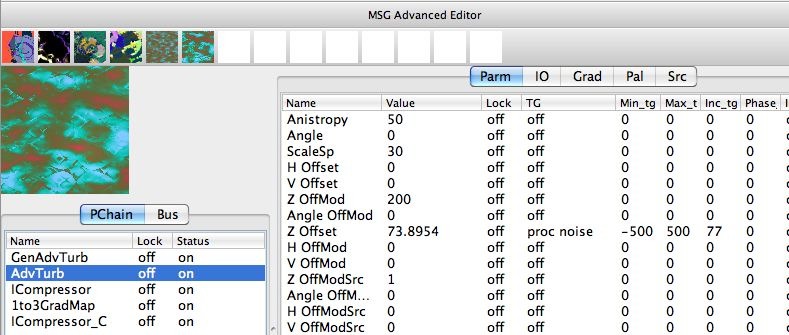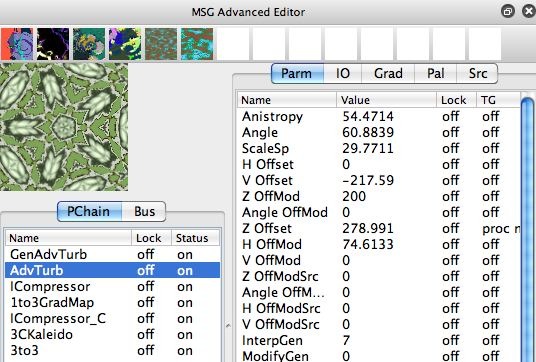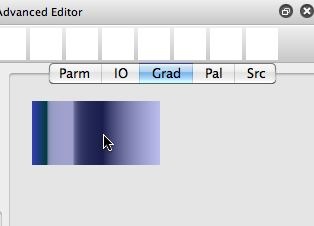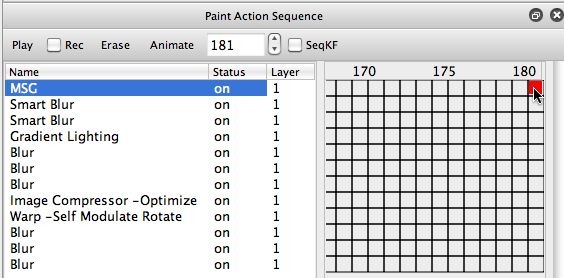This post continues yesterday’s post on building self-animating MSG presets that create abstract procedural animation. In this example we’ll combine self-animating behavior generated via attached temporal generators along with some additional MSG keyframe animation using the PASeq timeline.
I started with the final MSG preset we created in yesterday’s post. By clicking on the MSG Advanced Editor preview cell I generated a set of mutated variants of that preset in the Evolution Editor. By using the TG Evolution Preview context menu command in the Evolution Editor, I was able to observe the self-animating behavior of all of the mutated presets associated with the evolution preview cells. I picked on a particular evolution preview cell I like, and clicked on it to generate a new set of mutated variants derived from the preset preview I clicked on.
For more information on working with the TG Preview context menu commands to preview self-animating MSG presets, check out this previous post.
I wanted to add some kaleidoscopic symmetry to the overall abstract effect. To do this I used one of the MSG Editing commands in the integrated Help Browser. The particular configuration command meta edit I used was the Kaleido-indirect metaedit command shown below.
For more information on working with MSG Configuration commands check out this previous post.
I could have manually made the editing changes to the processor chain editor in the MSG Advanced Editor to add the kaleidoscopic geometric transformation. I used the configuration meta-edit command link instead of manual editing because it’s a fast way to build any of the pre-built configuration meta-edit effects.
After clicking on the Kaleido-indirect metaedit configuration command, the Evolution Editor updated to display new presets that incorporated the kaleidocopic geometric distortion I added when I ran the metaedit command. The image gallery below shows the new evolution preview cells meta-edited to incorporate a kaleidoscopic geometric distortion and the associated changes in the MSG Advanced Editor introduced by the meta-edit configuration command. Note the 2 additional processors added at the end of the processor chain that build the kaleidoscopic effect.
I also wanted the color gradient associated with the MSG preset to change over time in the animation. I did this by using the MSG preset as an action step in a paint action sequence (PASeq), and adding a keyframe for the MSG action step at the first and last frame in the animation (181 frames total).
The image gallery below shows the color gradient tab editor in the MSG Advanced editor for the first keyframe, the last keyframe, and the PASeq used to build the animation effect. I used the h hotkey to interactively adjust the hue of the color gradient. I also used the s hotkey to boost the saturation of the color gradient a little as well.
I first recorded the MSG action step in the PASeq by turning on PASeq recording and then running the MSG preset. I then edited the color gradient in the MSG Advanced editor. I then option clicked keyframe 181 associated with the MSG action step to record the second keyframe with the modified MSG preset using the adjusted color gradient.
The third image in the gallery below shows the PASeq used for my final animation. Note the second keyframe for the first MSG action step recorded at keyframe 181. The MSG action step is doing most of the work. All of the other action steps in the PASeq can be considered finished enhancements. The image is sharpened, a slight lighting gradient is added, it’s slightly interactively warped modulated by a smoothed version of itself, and the contrast is boosted.
The final animation example generated using the above PASeq can be seen here.












